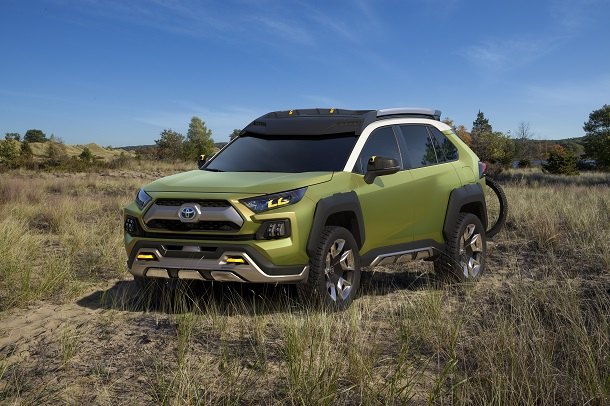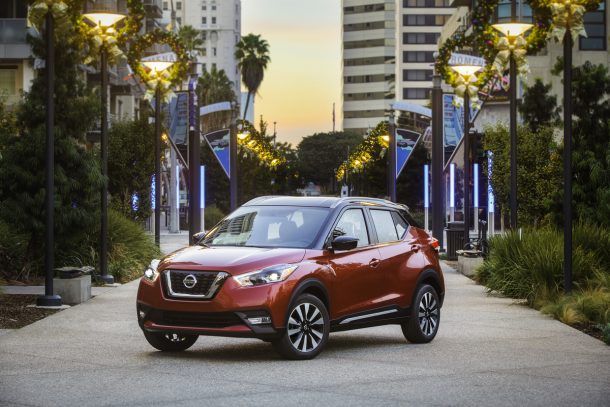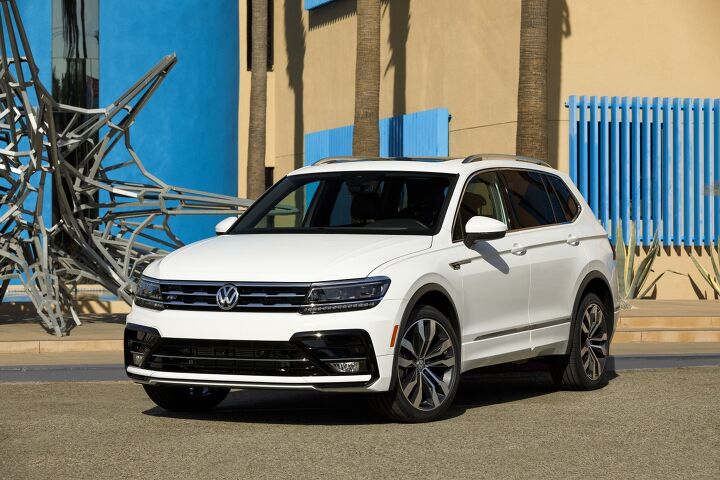#Crossovers
It's The End of the Sedan as We Know It (and I Feel Fine)
Actually, I don’t feel fine. Far from it, in fact. Ever since I can remember, there has been a three-box sedan in my family’s driveway — both before and after I was old enough to buy by own vehicles. Midsize sedans used to be the default choice for most families in my hardscrabble hometown, parked cheek-to-jowl with rusty pickups at the local grocery store.
Now, our inky-black Charger is the exception rather than the rule in the school drop-off queue. Save for a CTS next door and a Mazda 3 down the street, we’re about the only household around with a sedan in the drive. The midsize four-door is in a bad way.
Chinese Startup Byton Teases Electric 'SIV' Ahead of CES Debut
Even though automotive trade shows are becoming more tech-focused, its still a difficult environment for a fledgling carmaker to break into. That’s one reason the Consumer Electronics Show, now just called “CES,” has hosted so many Chinese startups these last few years. One of the newest is the e-car manufacturer Byton, formerly known as Future Mobility.
While Byton sounds more like the name of a vehicle than a brand — especially since it was, two months earlier — it’s infinitely better than mashing two of the auto industry’s most-popular buzzwords together and pretending it means something. The company was also wise to get away from any moniker that might allow the public to confuse it with Faraday Future.
However, adopting the name of its singular model means Byton had to come up with something new for the vehicle scheduled to make its world debut at CES next week. Now dubbed the SIV (smart intuitive vehicle), the Chinese-brand is promising a “next generation smart device” that is “uniquely built for the coming era of truly shared, smart mobility and autonomous driving.”
2019 Acura RDX Shows Some Leg Ahead of Detroit Debut
This week, Acura teased the prototype of its third-generation RDX ahead of its world debut at the 2018 North American International Auto Show in Detroit. Claiming its to be the “most extensive Acura redesign in more than a decade,” the brand believes it will usher in a “new era” for the company.
While the shadowy images hint at more aggressive and angular styling, the RDX needs more than a pretty face to compete in an increasingly crowded segment. It seems as if every luxury automaker fields a midsize crossover these days, though often at higher price points than the RDX. However, Acura isn’t going to bunt here and hope a freshened model boosts this years’ weaker sales. It’s bringing an entirely new platform that’s exclusive to the brand.
As Spartanburg Slowly Births the BMW X7, an Ever-growing Pool of Buyers Awaits
It certainly feels like BMW is taking its sweet time getting the full-size, three-row X7 to market, but the automaker assures us it’s almost here. Announced yesterday, pre-production models are now rolling off BMW’s Spartanburg, South Carolina, assembly line — a major step in a product timeline that began in 2014.
Offering up an all-important third row and front end styling that’s sure to spark debate (this year’s X7 iPerformance concept set a high bar for controversy and grille size), the production model should be ready for a late 2018 debut. In the meantime, certification drudgery and copious amounts of hot and cold weather testing awaits.
As the sole member of the Big German Three without a three-row SUV (SAV in BMW parlance), the X7 is a much-needed vehicle, and not just because the automaker wants more high-margin vehicles to fund its electrification efforts. True, the new car market is contracting, but big premium utility vehicles sell.
Topical: Nissan's Okay With a Front-drive Crossover, but Toyota Has Regrets
This morning’s Question of the Day was all about all-wheel drive and which models could stand a dose of four-wheel traction. So far, no one’s talking about the Nissan Versa Note.
Nissan, however, is more than happy to talk about the fact that its upcoming Kicks subcompact crossover will arrive with power relegated only to the front wheels. Hardly a brawny setup for a high-riding vehicle, but the automaker doesn’t seem to care much about the buyers it might be leaving behind. Toyota, on the other hand, harbors lingering regrets over its entry in the B-segment class, the C-HR.
Acura Drops Another Hint of a U.S.-bound CDX
Officially, there is no word. Unofficially, Acura seems plenty content with the idea of bringing the Chinese-market CDX subcompact crossover to North America, so long as there’s a business case for it.
“It’s a model that interests a lot of our people, so we have our R&D guys looking into the possibility,” said Jon Ikeda, vice president of American Honda’s Acura division, last April.
Is an American design patent granted to Honda proof that the company’s braintrust have made up their minds?
Spied: 2019 Cadillac XT4, Ready to Do What Sedans Can't
By “can’t,” we mean “keep the division afloat.” The luxury brand’s sedan sales just aren’t cutting it anymore, forcing Cadillac to play a game of crossover catch-up with other players in the premium field. While the full-size Escalade and midsize XT5 remain strong (and consistent) sales performers, many of Cadillac’s rivals offer more utility vehicle choice. Lexus has four, and might not consider that enough. Even Lincoln has three.
The first of several answers to this problem is the XT4, a compact crossover positioned just below the XT5. Debuting in the middle of next year as a 2019 model, the new crossover recently made an appearance outside General Motors’ Milford proving grounds. Luckily, a cameraman was there.
Lexus Promises 'Flagship' Crossover Concept in Detroit; Is There Room for Another Model in the Lineup?
Toyota’s luxury division isn’t in the habit of leaving certain vehicle segments wide open for other automakers to plunder. Lexus fields not one, but two sport coupes, just in case one of the few buyers not interested in sedans and SUVs wanders into the dealership.
In the utility vehicle department, it seems Lexus has all bases covered, Or at least it soon will. There’s the compact NX crossover, the midsize RX (soon to be available in a longer, three-row variant), the midsize, body-on-frame GX, and the range-topping, BOF LX full-sizer (now with fewer seats, should you prefer it). There’s even a possibility of a subcompact Lexus utility in the near future.
So, what exactly is Lexus missing? A “flagship” crossover, it seems.
The 1990s Return at Toyota; Automaker Prepares to Double Up in a Single Segment
What’s stopping Toyota from fielding more than one vehicle in a single class? Answer: absolutely nothing, assuming there’s sales to be had.
After unveiling three crossover concepts over the course of the calendar year, the automaker, not unsurprisingly, now says it’s going to go ahead and build one. Sure, the body might revert to something a little less showy, but the decision means Toyota diehards will soon gain more choice — and the opportunity to pass over a vehicle many reviewers find lacking.
U.S. Dealers Plead for a Smaller Lexus Crossover
If American dealers get their way, Lexus’ planned subcompact crossover — first shown in concept form last year — won’t be the strictly Europe-focused proposition the brand’s parent company intended.
The UX concept, introduced at the 2016 Paris Auto Show, shares its architecture with the Toyota C-HR and is already scheduled for production. We’ll see the model debut in Geneva next March. Lexus Europe is positioning the model as a new entry point for the brand’s utility lineup, designed to appeal to urbanites used to navigating tight spaces.
But European city-dwellers aren’t the only ones who took notice of the UX concept. Dealers in the U.S. are clamoring for a chance to bulk up their growing lineup with something small. It’s something Lexus is now considering.
Volkswagen Confirms an I.D. Crozz-based Crossover, a Future Chattanooga Resident
It’s hard picturing the world automakers have painted for us. You know the one — it’s the exciting, progressive near-future vision in which electric crossovers sprout from everywhere all at once, instantly winning the approval of a populace hooked on the convenience of gasoline.
With the all-electric vehicle’s market share hovering at just over half of one percent in the United States, it’s difficult to imagine the needle budging significantly by 2020. Or even 2025. Still, an ever-increasing number of automakers are promising exactly this. Volkswagen’s among them, announcing at this week’s L.A. Auto Show that its horribly named I.D. Crozz concept will form the basis of a new crossover that arrives stateside in 2020, followed two years later by a reborn electric Microbus (or I.D. Buzz, in VW parlance).
Get Yer Kicks: Nissan's Latest Utility Vehicle Will Soon Be Its Tiniest
The dubious long-term sales potential of the subcompact crossover segment isn’t swaying Nissan from introducing a B-segment vehicle in the United States. The automaker’s seventh utility vehicle, carrying the youthful name Kicks, debuted at the L.A. Auto Show today.
The Kicks is the only way Americans can take home any part of a Nissan Micra, as the diminutive crossover rides atop a second-generation version of that vehicle’s platform. The first-generation platform, you’ll recall, underpinned the funky Nissan Juke. That model, known for its polarizing styling, isn’t long for this world.
In its place, the Kicks offers slightly larger dimensions and — most importantly — safe and modern styling.
2018 Lexus RX L Delivers Third-row Seating, New LX Cargo Variant Removes It
One of the biggest gripes when it comes to crossovers is that they swept in to replace minivans without offering much in the way of utility. Traditional SUVs are boxy behemoths, capable of holding as many children as you can produce. But smaller crossovers rarely get third-seating and, when they do, it’s sometimes an overly cramped solution that sacrifices important cargo space. However most families wouldn’t mind having the option of choosing between extra kids and additional luggage.
Having been around since 1998, the Lexus RX pioneered the midsize luxury crossover segment. But, despite consistently strong sales in the United States, it missed out on reeling in those bigger broods. Lexus shoppers with family photos that included more than five heads had to opt for the more expensive GX and LX sport utility models.
Fortunately, the company has remedied that problem by adding a three-row variant for the 2018 model year.
2019 Lincoln Nautilus: Former MKX Dials Up the Brougham
As we learned yesterday, the midsize Lincoln MKX will soon be no more, replaced by a vehicle that’s very similar in appearance but definitely not in name. Nautilus, the Jules Verne-inspired moniker that graces the crossover’s flanks starting next summer, is a signal that real names are back, baby. Take note, rival automakers.
Besides freeing the former MKX from the abyss of alphanumeric naming hell, the arrival of Nautilus means significant powertrain changes and a design detour — pushing Lincoln’s best-selling model ever so slightly further upscale while adding a dose of fuel savings.
Volkswagen Tosses Out an R-Line Tiguan as It Waits for More Crossovers
Volkswagen’s American fortune will not come by way of an electric, next-generation Beetle. No, the automaker’s U.S. game plan rests firmly on the success of existing and future utility vehicles. With no new models kicking around to bring to L.A., the automaker decked out its recently introduced second-generation Tiguan in ever-so-edgy R-Line trim and headed to the show.
Featuring an added (but not heaping) dose of visual aggression, the Tiguan R-Line, available in the first quarter of 2018, should give crossover buyers something new to look at while the company fleshes out its lineup with new tenants. It’s early days yet, but it seems the company’s crossover push is already working.






























Recent Comments